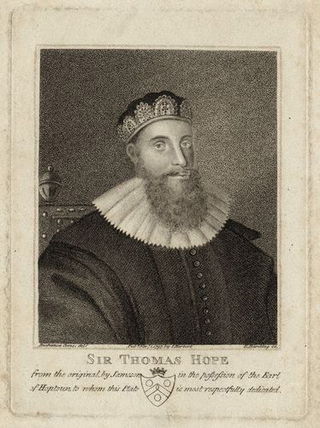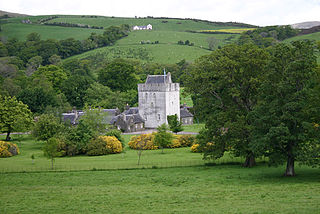
George Bannatyne (1545–1608), a native of Angus, Scotland, was an Edinburgh merchant and burgess. He was the seventh of twenty-three children, including Catherine Bannatyne, born of James Bannatyne of Kirktown of Newtyle in Forfarshire and Katherine Tailefer. He is most famous as a collector of Scottish poems. He compiled an anthology of Scots poetry while in isolation during a plague in 1568. His work extended to eight hundred folio pages, divided into five parts. The anthology includes works from Scottish Chaucerians as well as many anonymous writers.
This article contains information about the literary events and publications of 1608.

Patrick Fraser Tytler FRSE FSA(Scot) was a Scottish advocate and historian. He was described as the "Episcopalian historian of a Presbyterian country".
Richard Holland or Richard de Holande was a Scottish cleric and poet, author of the Buke of the Howlat.
John Bellenden or Ballantyne of Moray was a Scottish writer of the 16th century.
The Bannatyne Club, named in honour of George Bannatyne and his famous anthology of Scots literature the Bannatyne Manuscript, was a text publication society founded by Sir Walter Scott to print rare works of Scottish interest, whether in history, poetry, or general literature. The club was established in 1823 and printed 116 volumes before being dissolved in 1861.

Sir Thomas Hope, 1st Baronet Hope of Craighall (1573–1646) was a Scottish lawyer, and Lord Advocate under Charles I.
John Colville, Scottish clergyman, judge, politician and author, was the son of Robert Colville of Cleish, in Kinross.
William Ruthven, 1st Earl of Gowrie, 4th Lord of Ruthven was a Scottish peer known for devising the Raid of Ruthven.
The Ragman Rolls are the collection of instruments by which the nobility and gentry of Scotland subscribed allegiance to King Edward I of England, during the time between the Conference of Norham in May 1291 and the final award in favour of Balliol in November 1292; and again in 1296. Of the former of these records two copies were preserved in the Chapter House at Westminster Abbey, and it has been printed by Thomas Rymer. Another copy, preserved originally in the Tower of London, is now also in the National Archives. The latter record, containing the various acts of homage and fealty extorted by Edward from John Balliol and others in the course of his progress through Scotland in the summer of 1296 and in August at the parliament of Berwick, was published by Prynne from the copy in the Tower and now in the National Archives. Both records were printed by the Bannatyne Club in 1834.
Ballantine is a surname of Scottish Gaelic origin. It is first found in Lanarkshire, where the family had been settled since ancient times. The name has also been variously spelled Ballantyne, Bannatyne, Ballanden, and Ballentine.

John Mylne was a Scottish master mason, the first of three successive generations of the name to serve as Master Mason to the Crown of Scotland. He was born in Dundee into a family of master builders. His great-grandfather, also John, had been Master Mason to both James III and James IV. He was the son of Thomas Mylne, Master Mason to the Crown and burgess of Dundee. His grandfather may have been Robert Mylne former provost of Dundee.

Kames Castle is a 16th-century tower house located on the shore of Kames Bay near Port Bannatyne, on the Isle of Bute, Scotland. The castle, which is set in 20 acres (81,000 m2) of planted grounds, includes a 2-acre (8,100 m2) 18th-century walled garden. It is extended through the addition of a range of stone cottages. The castle, cottages, walled garden and other estate buildings are category B listed buildings.

Sir William Macleod Bannatyne, Lord Bannatyne FRSE was a distinguished Scottish advocate, judge, antiquarian and historian.
Alexander Scott was a Scottish Court poet. He is believed to have spent most of his time in or near Edinburgh. Thirty-six short poems are attributed to him, including Ane New Yeir Gift to Quene Mary, The Rondel of Love, and a satire, Justing at the Drum. His poems are included in the Bannatyne Manuscript (1568) complied by George Bannatyne. According to an older view, "he has great variety of metre, and is graceful and musical, but his satirical pieces are often extremely coarse".

The Bannatyne Manuscript is an anthology of literature compiled in Scotland in the sixteenth century. It is an important source for the Scots poetry of the fifteenth and sixteenth centuries. The manuscript contains texts of the poems of the great makars, many anonymous Scots pieces and works by medieval English poets.
David Moysie was a Scottish notary public, known as the author of the Memoirs of the Affairs of Scotland, 1577–1603.

The Battle of Craibstone was fought on 20 November 1571 between Clan Gordon and the Clan Forbes on an area that has now been constructed over, found in central Aberdeen, Scotland. It was part of the Marian civil war in which the Clan Forbes supported the King James VI and the Clan Gordon supported Mary, Queen of Scots.
Adam Gordon of Auchindoun (1545–1580) was a Scottish knight, younger brother of the Earl of Huntly and military leader during the Marian civil war on behalf of Mary, Queen of Scots in north west Scotland. In Scottish ballad lore, Adam became known as Edom o'Gordon.
John James Bannatyne RSW was a late 19th and early 20th century Scottish painter and watercolourist specialising in Highland landscapes and seascapes.






